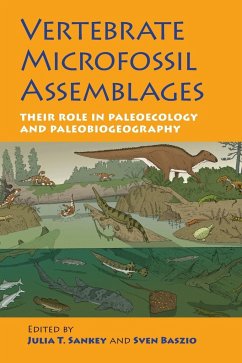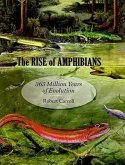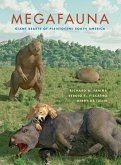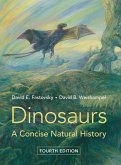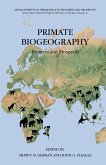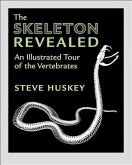Julia T. Sankey / Sven BaszioTheir Role in Paleoecology and Paleobiogeography
Vertebrate Microfossil Assemblages
Their Role in Paleoecology and Paleobiogeography
Herausgeber: Sankey, Julia T; Baszio, Sven
Julia T. Sankey / Sven BaszioTheir Role in Paleoecology and Paleobiogeography
Vertebrate Microfossil Assemblages
Their Role in Paleoecology and Paleobiogeography
Herausgeber: Sankey, Julia T; Baszio, Sven
- Gebundenes Buch
- Merkliste
- Auf die Merkliste
- Bewerten Bewerten
- Teilen
- Produkt teilen
- Produkterinnerung
- Produkterinnerung
Analysis of the data produced from microvertebrate localities can address a wide range of questions as these papers clearly demonstrate.
Andere Kunden interessierten sich auch für
![The Rise of Amphibians The Rise of Amphibians]() Robert CarrollThe Rise of Amphibians73,99 €
Robert CarrollThe Rise of Amphibians73,99 €![The Philosophy of Zoology Before Darwin The Philosophy of Zoology Before Darwin]() Alex McBirneyThe Philosophy of Zoology Before Darwin112,99 €
Alex McBirneyThe Philosophy of Zoology Before Darwin112,99 €![Megafauna Megafauna]() Richard A FariñaMegafauna63,99 €
Richard A FariñaMegafauna63,99 €![Dinosaurs Dinosaurs]() David E. FastovskyDinosaurs213,99 €
David E. FastovskyDinosaurs213,99 €![Primate Biogeography Primate Biogeography]() Primate Biogeography75,99 €
Primate Biogeography75,99 €![The Skeleton Revealed The Skeleton Revealed]() Steve HuskeyThe Skeleton Revealed56,99 €
Steve HuskeyThe Skeleton Revealed56,99 €![Niederlandisches Archiv Fur Zoologie Niederlandisches Archiv Fur Zoologie]() HoffmannNiederlandisches Archiv Fur Zoologie42,99 €
HoffmannNiederlandisches Archiv Fur Zoologie42,99 €-
-
-
Analysis of the data produced from microvertebrate localities can address a wide range of questions as these papers clearly demonstrate.
Hinweis: Dieser Artikel kann nur an eine deutsche Lieferadresse ausgeliefert werden.
Hinweis: Dieser Artikel kann nur an eine deutsche Lieferadresse ausgeliefert werden.
Produktdetails
- Produktdetails
- Verlag: Indiana University Press
- Seitenzahl: 296
- Erscheinungstermin: 1. April 2008
- Englisch
- Abmessung: 260mm x 183mm x 20mm
- Gewicht: 747g
- ISBN-13: 9780253349279
- ISBN-10: 0253349273
- Artikelnr.: 22943868
- Herstellerkennzeichnung
- Libri GmbH
- Europaallee 1
- 36244 Bad Hersfeld
- gpsr@libri.de
- Verlag: Indiana University Press
- Seitenzahl: 296
- Erscheinungstermin: 1. April 2008
- Englisch
- Abmessung: 260mm x 183mm x 20mm
- Gewicht: 747g
- ISBN-13: 9780253349279
- ISBN-10: 0253349273
- Artikelnr.: 22943868
- Herstellerkennzeichnung
- Libri GmbH
- Europaallee 1
- 36244 Bad Hersfeld
- gpsr@libri.de
edited by Julia T. Sankey, Sven Baszio
Contents
Preface. Sven Baszio
Part 1. Importance of Microvertebrate Sites, Sampling, Statistical Methods,
and Taphonomy
1. Information from Microvertebrate Localities: Potentials and LimitsSven
Baszio
2. How Much Is Enough? A Repeatable, Efficient, and Controlled Sampling
Protocol for Assessing Taxonomic Diversity and Abundance in Vertebrate
Microfossil AssemblagesHeather A. Jamniczky, Donald B. Brinkman, and
Anthony P. Russell
3. Taphonomic Issues Relating to Concentrations of Pedogenic Nodules and
Vertebrates in the Paleocene and Miocene Gulf Coastal Plain: Examples from
Texas and Louisiana, USAJudith A. Schiebout, Paul D. White, and Grant S.
Boardman
Part 2. Guild Analysis, Ecological and Faunal Analyses, Biodiversity, and
Paleobiogeography
4. The Structure of Late Cretaceous (Late Campanian) Nonmarine Aquatic
Communities: A Guild Analysis of Two Vertebrate Microfossil Localities in
Dinosaur Provincial Park, Alberta, CanadaDonald Brinkman
5. Vertebrate Paleoecology from Microsites, Talley Mountain, Upper Aguja
Formation (Late Cretaceous), Big Bend National Park, Texas, USAJulia T.
Sankey
6. Terrestrial and Aquatic Vertebrate Paleocommunities of the Mesaverde
Formation (Upper Cretaceous, Campanian) of the Wind River and Bighorn
Basins, Wyoming, USA
David G. DeMar Jr. and Brent H. Breithaupt
7. Lack of Variability in Feeding Patterns of the Sauropod Dinosaurs
Diplodocus and Camarasaurus (Late Jurassic, Western USA) with Respect to
Climate as Indicated by Tooth Wear FeaturesAnthony R. Fiorillo
8. Diversity of Latest Cretaceous (Late Maastrichtian) Small Theropods and
Birds: Teeth from the Lance and Hell Creek Formations, USAJulia T. Sankey
9. Small Theropod Teeth from the Lance Formation of Wyoming, USANick
Longrich
10. The First Serrated Bird ToothPhilip J. Currie and Clive Coy
11. First Dinosaur Eggshells from Texas, USA: Aguja Formation (Late
Campanian), Big Bend National Park Ed Welsh and Julia T. Sankey
12. Review of the Albanerpetontidae (Lissamphibia), with Comments on the
Paleoecological Preferences of European Tertiary AlbanerpetontidsJames D.
Gardner and Madelaine Böhme
13. New Information on Frogs (Lissamphibia: Anura) from the Lance Formation
(Late Maastrichtian) and Bug Creek Anthills (Late Maastrichtian and Early
Paleocene), Hell Creek Formation, USAJames D. Gardner
List of Contributors
Index
Preface. Sven Baszio
Part 1. Importance of Microvertebrate Sites, Sampling, Statistical Methods,
and Taphonomy
1. Information from Microvertebrate Localities: Potentials and LimitsSven
Baszio
2. How Much Is Enough? A Repeatable, Efficient, and Controlled Sampling
Protocol for Assessing Taxonomic Diversity and Abundance in Vertebrate
Microfossil AssemblagesHeather A. Jamniczky, Donald B. Brinkman, and
Anthony P. Russell
3. Taphonomic Issues Relating to Concentrations of Pedogenic Nodules and
Vertebrates in the Paleocene and Miocene Gulf Coastal Plain: Examples from
Texas and Louisiana, USAJudith A. Schiebout, Paul D. White, and Grant S.
Boardman
Part 2. Guild Analysis, Ecological and Faunal Analyses, Biodiversity, and
Paleobiogeography
4. The Structure of Late Cretaceous (Late Campanian) Nonmarine Aquatic
Communities: A Guild Analysis of Two Vertebrate Microfossil Localities in
Dinosaur Provincial Park, Alberta, CanadaDonald Brinkman
5. Vertebrate Paleoecology from Microsites, Talley Mountain, Upper Aguja
Formation (Late Cretaceous), Big Bend National Park, Texas, USAJulia T.
Sankey
6. Terrestrial and Aquatic Vertebrate Paleocommunities of the Mesaverde
Formation (Upper Cretaceous, Campanian) of the Wind River and Bighorn
Basins, Wyoming, USA
David G. DeMar Jr. and Brent H. Breithaupt
7. Lack of Variability in Feeding Patterns of the Sauropod Dinosaurs
Diplodocus and Camarasaurus (Late Jurassic, Western USA) with Respect to
Climate as Indicated by Tooth Wear FeaturesAnthony R. Fiorillo
8. Diversity of Latest Cretaceous (Late Maastrichtian) Small Theropods and
Birds: Teeth from the Lance and Hell Creek Formations, USAJulia T. Sankey
9. Small Theropod Teeth from the Lance Formation of Wyoming, USANick
Longrich
10. The First Serrated Bird ToothPhilip J. Currie and Clive Coy
11. First Dinosaur Eggshells from Texas, USA: Aguja Formation (Late
Campanian), Big Bend National Park Ed Welsh and Julia T. Sankey
12. Review of the Albanerpetontidae (Lissamphibia), with Comments on the
Paleoecological Preferences of European Tertiary AlbanerpetontidsJames D.
Gardner and Madelaine Böhme
13. New Information on Frogs (Lissamphibia: Anura) from the Lance Formation
(Late Maastrichtian) and Bug Creek Anthills (Late Maastrichtian and Early
Paleocene), Hell Creek Formation, USAJames D. Gardner
List of Contributors
Index
Contents
Preface. Sven Baszio
Part 1. Importance of Microvertebrate Sites, Sampling, Statistical Methods,
and Taphonomy
1. Information from Microvertebrate Localities: Potentials and LimitsSven
Baszio
2. How Much Is Enough? A Repeatable, Efficient, and Controlled Sampling
Protocol for Assessing Taxonomic Diversity and Abundance in Vertebrate
Microfossil AssemblagesHeather A. Jamniczky, Donald B. Brinkman, and
Anthony P. Russell
3. Taphonomic Issues Relating to Concentrations of Pedogenic Nodules and
Vertebrates in the Paleocene and Miocene Gulf Coastal Plain: Examples from
Texas and Louisiana, USAJudith A. Schiebout, Paul D. White, and Grant S.
Boardman
Part 2. Guild Analysis, Ecological and Faunal Analyses, Biodiversity, and
Paleobiogeography
4. The Structure of Late Cretaceous (Late Campanian) Nonmarine Aquatic
Communities: A Guild Analysis of Two Vertebrate Microfossil Localities in
Dinosaur Provincial Park, Alberta, CanadaDonald Brinkman
5. Vertebrate Paleoecology from Microsites, Talley Mountain, Upper Aguja
Formation (Late Cretaceous), Big Bend National Park, Texas, USAJulia T.
Sankey
6. Terrestrial and Aquatic Vertebrate Paleocommunities of the Mesaverde
Formation (Upper Cretaceous, Campanian) of the Wind River and Bighorn
Basins, Wyoming, USA
David G. DeMar Jr. and Brent H. Breithaupt
7. Lack of Variability in Feeding Patterns of the Sauropod Dinosaurs
Diplodocus and Camarasaurus (Late Jurassic, Western USA) with Respect to
Climate as Indicated by Tooth Wear FeaturesAnthony R. Fiorillo
8. Diversity of Latest Cretaceous (Late Maastrichtian) Small Theropods and
Birds: Teeth from the Lance and Hell Creek Formations, USAJulia T. Sankey
9. Small Theropod Teeth from the Lance Formation of Wyoming, USANick
Longrich
10. The First Serrated Bird ToothPhilip J. Currie and Clive Coy
11. First Dinosaur Eggshells from Texas, USA: Aguja Formation (Late
Campanian), Big Bend National Park Ed Welsh and Julia T. Sankey
12. Review of the Albanerpetontidae (Lissamphibia), with Comments on the
Paleoecological Preferences of European Tertiary AlbanerpetontidsJames D.
Gardner and Madelaine Böhme
13. New Information on Frogs (Lissamphibia: Anura) from the Lance Formation
(Late Maastrichtian) and Bug Creek Anthills (Late Maastrichtian and Early
Paleocene), Hell Creek Formation, USAJames D. Gardner
List of Contributors
Index
Preface. Sven Baszio
Part 1. Importance of Microvertebrate Sites, Sampling, Statistical Methods,
and Taphonomy
1. Information from Microvertebrate Localities: Potentials and LimitsSven
Baszio
2. How Much Is Enough? A Repeatable, Efficient, and Controlled Sampling
Protocol for Assessing Taxonomic Diversity and Abundance in Vertebrate
Microfossil AssemblagesHeather A. Jamniczky, Donald B. Brinkman, and
Anthony P. Russell
3. Taphonomic Issues Relating to Concentrations of Pedogenic Nodules and
Vertebrates in the Paleocene and Miocene Gulf Coastal Plain: Examples from
Texas and Louisiana, USAJudith A. Schiebout, Paul D. White, and Grant S.
Boardman
Part 2. Guild Analysis, Ecological and Faunal Analyses, Biodiversity, and
Paleobiogeography
4. The Structure of Late Cretaceous (Late Campanian) Nonmarine Aquatic
Communities: A Guild Analysis of Two Vertebrate Microfossil Localities in
Dinosaur Provincial Park, Alberta, CanadaDonald Brinkman
5. Vertebrate Paleoecology from Microsites, Talley Mountain, Upper Aguja
Formation (Late Cretaceous), Big Bend National Park, Texas, USAJulia T.
Sankey
6. Terrestrial and Aquatic Vertebrate Paleocommunities of the Mesaverde
Formation (Upper Cretaceous, Campanian) of the Wind River and Bighorn
Basins, Wyoming, USA
David G. DeMar Jr. and Brent H. Breithaupt
7. Lack of Variability in Feeding Patterns of the Sauropod Dinosaurs
Diplodocus and Camarasaurus (Late Jurassic, Western USA) with Respect to
Climate as Indicated by Tooth Wear FeaturesAnthony R. Fiorillo
8. Diversity of Latest Cretaceous (Late Maastrichtian) Small Theropods and
Birds: Teeth from the Lance and Hell Creek Formations, USAJulia T. Sankey
9. Small Theropod Teeth from the Lance Formation of Wyoming, USANick
Longrich
10. The First Serrated Bird ToothPhilip J. Currie and Clive Coy
11. First Dinosaur Eggshells from Texas, USA: Aguja Formation (Late
Campanian), Big Bend National Park Ed Welsh and Julia T. Sankey
12. Review of the Albanerpetontidae (Lissamphibia), with Comments on the
Paleoecological Preferences of European Tertiary AlbanerpetontidsJames D.
Gardner and Madelaine Böhme
13. New Information on Frogs (Lissamphibia: Anura) from the Lance Formation
(Late Maastrichtian) and Bug Creek Anthills (Late Maastrichtian and Early
Paleocene), Hell Creek Formation, USAJames D. Gardner
List of Contributors
Index

